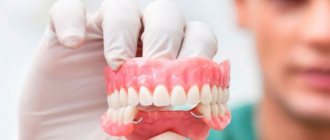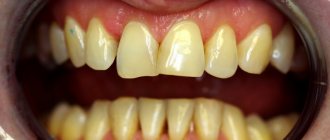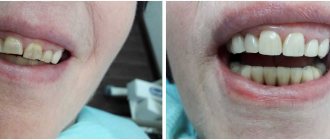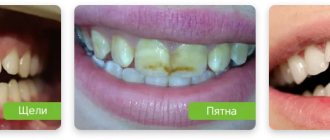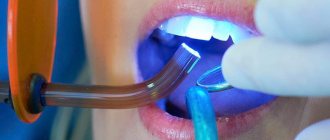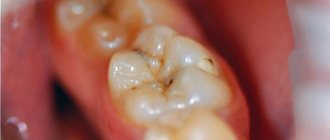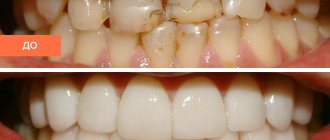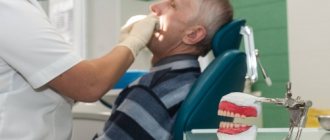One of the services frequently provided by our clinic is the installation of dentures (or prosthetics).
Dental prosthetics is the main direction of orthopedic dentistry. Even though there are other sections in orthopedics, it is prosthetics that is the most popular area, which is constantly developing and attracts the latest technologies and materials, as well as the latest achievements in the field of science.
If we consider dental restoration from the point of view of the usual understanding of orthopedic dentistry, then we can distinguish two types of restoration: restoration and dental prosthetics.
Tooth restoration involves maximizing their preservation and is carried out when a tooth is only partially lost. In this case, dental inlays or the installation of pins (rods) are usually used, which serve as the foundation for building up artificial teeth.
Many more different techniques are used in prosthetics:
What is dental restoration
Dental restoration refers to the process of restoring the shape and functionality of damaged teeth.
If we are talking not only about tooth restoration, but also about the aesthetic component, then such terms (synonyms) as artistic restoration, cosmetic restoration or aesthetic restoration of teeth are applicable.
Dental restoration is a dental procedure aimed at both improving the appearance and bringing the teeth to a state as close as possible to the physiological state.
- The goal of restoration is to optimize the color and shape of the tooth so that the restored tooth is indistinguishable from other teeth.
- During restoration, correction and restoration of functionality and aesthetics are carried out using composite materials directly in the patient’s mouth or outside it.
- Tooth restoration differs from the installation of a filling in that tooth restoration is carried out using modern aesthetic materials that allow you to imitate enamel and dentin in the desired transparency and color range.
Aesthetic dentistry
Aesthetic dentistry
– a popular direction, the purpose of which is to treat and improve the appearance of teeth.
Achievements in aesthetic dentistry are based on the most modern developments of scientists. Our clinic uses only high-quality filling materials, instruments and equipment. The work of a dentist can only be compared with the profession of a jeweler. It is necessary to reproduce a tooth affected by caries with millimeter accuracy and restore the natural beauty of the enamel. As a result, the restored part of the tooth is almost impossible to distinguish from the structure and shape of the natural tooth. This is very important, for example, for the front teeth that are visible when smiling. For you, a specialist will select an individual material that matches the color, taking into account its transparency and saturation. After restoration, the teeth will perform all their usual functions. We know that for many people, going to the dentist is a very important and exciting step. The comfort and mood of our patients is important to us. We take into account all indications and contraindications in aesthetic dentistry, provide guarantees for our services and create the most comfortable atmosphere for you. During the treatment you will be able to watch a TV specially attached to the chair and the ceiling. And the best part is that you can carry out all the treatment while lying in a chair. Make an appointment and get the smile of your dreams! We are open to you and will be happy to answer all your questions! Aesthetic restorations - from 5,000 rubles.
Aesthetic restorations are the restoration of the integrity of the teeth of the anterior or chewing group by recreating the anatomical shape, tissues, and functions of the tooth. To recreate the original data, the following types of restorations are used:
- straight.
It is performed directly in the oral cavity, when restoration using composite materials is possible. During the procedure, the surface to be restored is cleaned, the tooth is prepared, and layer-by-layer application (the so-called “tooth building”) of composite material is performed to give the tooth the required shape. - indirect.
In this case, in a laboratory setting, a dental technician models the surface of the tooth, and the doctor fixes such a structure with special cement. Modern composite materials are quite durable, so in some cases restoration is also possible on the lateral teeth.
During your consultation, our specialist will tell you how to care for your restored teeth, what you should and shouldn’t do to maintain a beautiful smile. The cost of the service is from 5,000 rubles.
Composite veneers - from 7,000 rubles.
Composite veneers are an alternative to porcelain veneers. To eliminate surface defects of teeth, with microcracks, minor irregularities in the dentition, small chips of the edge of the tooth, non-carious lesions of the teeth. Typically, the procedure takes place directly in the patient's mouth. Our doctors use high-quality light-curing filling material, which has high wear resistance, to make composites. To preserve the original color of the restoration, we recommend not using whitening toothpastes (they are highly abrasive) and periodically visiting the dentist for polishing.
The cost of the service is from 7,000 rubles.
Dental decoration - from 2,000 rubles.
Decorating teeth is not only beautiful, but also safe. The procedure is carried out by a dentist within 15 minutes and is absolutely painless. To ensure high adhesive properties, the contacted surface is treated, then glue - bond - is applied pointwise. We note that when performing this procedure, the enamel is not injured at all, which allows you not to worry about the health of your teeth. Small stones and rhinestones on the frontal group of teeth, as well as products made from precious materials, are used as dental decorations.
The cost of the service is from 2,000 rubles.
Restoration of tooth function—from RUB 7,000
Teeth take part in the most important process in human life - chewing food, on which overall health, including digestion, depends. That is why restoration of tooth function is a priority. The best option is permanent prosthetics; it has a number of advantages: it is durable and reliable, repeats the anatomical structure of your teeth, allows you to evenly distribute the chewing load, does not require habituation, and does not impair diction.
The cost of this procedure depends on the degree of destruction and ranges from 7,000 rubles.
Splinting
Splinting is the fastening of teeth with a special tape, which allows for a strong horizontal connection between adjacent teeth. This procedure does not cause discomfort to the patient and is aimed at eliminating tooth mobility due to periodontal diseases and injuries. The tire is made of aramid thread or fiberglass. The latter material is used more often; it has higher strength and is not noticeable when worn. At the preparation stage, the surface of the teeth is cleaned, processed, and then a splint is applied, which firmly holds the teeth together, preventing them from loosening. When chewing food, the load is distributed evenly between them. Splints can be temporary or permanent. We will assess the integrity of the dentition, the degree of destructive changes, as well as other factors affecting tooth mobility and carry out the necessary treatment.
Sign up for a consultation and find out more about this opportunity! The cost of such structures starts from 6,000 rubles.
Restoring aesthetics - from 7,000 rubles.
Each of us wants to be the owner of, if not a Hollywood smile, then at least straight, healthy, white teeth. By nature, not everyone is given the full range of such qualities of a smile. That is why, more and more often, clients are turning to cosmetic dental restoration - to straighten the cutting edge of a tooth, whiten teeth, hide a defect in the dentition. Often, after injury or endodontic treatment, a tooth loses its natural whiteness and this causes severe discomfort to the patient, especially if it is a front tooth.
An advanced color change method includes veneers. Used in cases where dental whitening has failed to achieve the desired result. This requires less significant grinding of the teeth than when installing crowns. They improve the shape and color of teeth. In each specific case, consultation with a specialist is necessary to make the right decision. If you wear braces and have any questions regarding restoration or dental care after removal of the structure, be sure to contact our clinic for a consultation!
Our specialists will conduct a full examination, select the best treatment plan for you and answer all your questions!
Indications and contraindications
Dental restoration is carried out in the following cases:
- Correction of tooth shape, color and size.
- If the tooth has changed its position in the row.
- If the patient has crooked teeth.
- After treatment of caries, which aims to restore the aesthetics of the tooth.
- When the enamel darkens and there is pigmentation.
There are also some contraindications for restoration:
- Having an allergy to the composite material or its adhesives.
- If it is impossible to isolate the tooth and its cavity from moisture.
- Combination of pathological tooth wear and direct bite.
- Bruxism.
- Deep incisal overlap.
- Poor or lack of oral care.
Various methods and methods of dental restoration can solve the following problems:
- Correct the shape of the tooth.
- Eliminate chips and irregularities.
- Restoration of tooth enamel.
- Hide the gap between teeth.
- Align the position of the tooth in the row.
Removable prosthetics
In recent years, removable prosthetics has grown significantly in terms of the materials and technologies used, and the installed structures have become much more aesthetically pleasing and comfortable than those previously used.
Today, such designs are widespread due to the rational balance between aesthetics, price and quality. A removable plate denture is a plastic base that fits tightly to the gum and holds dentures. Such a prosthesis is made individually for the patient, and therefore is unique in various respects. Therefore, there are dozens of varieties of materials and their combinations and hundreds of types of removable denture designs. Such dentures are not suitable for everyone due to the need to remove them every day to ensure oral hygiene and the denture itself.
Methods
Depending on the condition of the patient's teeth, the following may be used:
- Direct recovery. For direct restoration, all manipulations are performed in the patient’s mouth during one medical appointment.
Direct restoration method
To restore the crown part of a tooth, composite dental restoration is used, which involves the use of photopolymers (light-curing composite materials): composites, compomers, heliocomposites, nanocomposites.
- Composite filling materials are held in place by chemical bonds with the enamel through glue (adhesive).
- Compomers additionally release fluoride, which helps strengthen the enamel.
- Heliocomposites allow you to select the desired color and recreate natural light transmission.
- Nanocomposites are capable of imitating the optical properties of fabrics.
Dental restoration with photopolymers is carried out by a dentist-therapist and is often called artistic restoration of teeth.
Life time
No dentist can say how long such a restoration will last, since this period is individual for each patient.
- It depends on oral care, the presence or absence of bad habits, etc.
- If the diet consists of food, mainly of plant origin, then the restoration will last a long time.
- The professionalism of the dentist and compliance with all installation rules and regulations also play an important role.
The average lifespan of a light seal is five years, but can be longer.
Other methods of direct restoration:
- Installing tabs.
- In case of large losses of dental tissue, the installation of pin structures is most often used.
Based on them, a new tooth is subsequently formed.
- Before fixing the pin, the root canal is prepared.
- Then the pin is fixed into the root cavity using special cement or using modern adhesive materials.
- The most popular are anchor, titanium, fiberglass, and silver pins.
Main indications
- Visible damage to tooth enamel due to physical impact or other external factors.
- Cracks on the surface of the tooth.
- Changes in enamel color. For example, yellowing or dark areas due to illness.
- The formation of a visible gap between the teeth, which spoils the smile and causes discomfort when eating.
- Malocclusion.
- Trauma to one or more teeth.
In many cases, artistic restoration is carried out in conjunction with treatment. First, the dentist eliminates the disease and then restores the appearance of the tooth. Before the procedure, professional consultation is required. The doctor examines the patient and selects the optimal method of aesthetic restoration.
Stages of implementation
The main stages of dental restoration are identified:
- Preparatory. At this stage, professional teeth cleaning is carried out, the color of the future tooth is determined and the shade of the composite material that will be used for restoration is selected accordingly.
- If necessary, local anesthesia is administered.
- Dental tissue affected by caries is drilled out. In case of replacing an old restoration, the old filling is drilled out and replaced with a new one.
- The tooth is isolated from saliva using a rubber dam - a latex scarf that is placed on the teeth through special holes. A restoration made from a composite without reliable isolation from saliva is not able to last long and can cause problems such as the appearance of a dark stripe or the formation of caries at the filling-tooth interface, as well as loss of the restoration.
In case of large losses of dental tissue, the installation of pin structures is most often used. Based on them, a new tooth is subsequently formed. The most popular are anchor, titanium, fiberglass, and silver pins.
- Before fixing the pin, the root canal is prepared.
- Then the pin is fixed into the root cavity using special cement or using modern adhesive materials.
- Restoration of tooth shape. To make the tooth look like a real one, a layer-by-layer restoration technique is used. Layers of composite of different shades and transparency are applied sequentially. Which will ultimately give the new tooth a natural appearance.
- Final shaping of the tooth into the required shape using burs, grinding and polishing of the filling.
Stages of restoration with veneers
- The color of the future veneer is selected.
- Local anesthesia is administered (if necessary).
- The front surface of the tooth is ground. The amount of tissue removed depends on the clinical case. Grinds down from 0.5 to 1.5 mm of hard tissue.
- Taking impressions.
- Fixation of temporary plastic plates while the permanent restoration is being manufactured. This measure is necessary to protect the ground tooth surface from infection and the negative effects of environmental factors.
- Production of a veneer onlay based on the impressions obtained in the laboratory.
- Fixing the veneer to the tooth using special glue.
Direct and indirect artistic restoration
Modern technologies and materials used for dental restoration make it possible to restore even half-damaged teeth. Today there are two methods of artistic restoration:
- Direct restoration
- suitable for cases where the tooth crown is destroyed by no more than one third.
This method is performed in one visit - after cleaning the tooth from plaque and stone, shades of filling materials are selected that are as close as possible to the color and transparency of the tooth tissue. Next, the dentist numbs the corresponding tooth and isolates it from saliva, after which he gently grinds off the enamel. The most painstaking and responsible part of the work
is the layer-by-layer application of the composite to recreate the natural appearance and relief of the tooth. The final stages are grinding and polishing. - Indirect restoration
- restoration using thin ceramic onlays (veneers and lumineers), which are ideal for front teeth.
In their appearance they cannot be distinguished from natural enamel. Also, such microprostheses are strong and durable - they can withstand the chewing load and even protect tooth tissue from the development of caries. The peculiarity of this method
is that it is performed in several stages. To begin with, the dentist prepares the teeth for prosthetics and takes impressions with an elastic mass, which are used to obtain plaster models of the patient’s jaws. During the first visit, the teeth are covered with temporary structures. Next, the dental technician prepares the onlays in the laboratory and hands them over to the doctor, who makes the final installation.
The choice of a specific method of artistic restoration is made by the dentist based on the condition of the teeth, the patient’s budget and the result he expects.
How much does it cost to restore teeth?
Prices for artistic restoration at the SiriusDent dental clinic in Bryansk depend on the following factors:
- method - direct or indirect;
- dental materials used;
- workload;
- size of tooth destruction, type and location of the defect;
- the need to use additional equipment (pins, anesthesia, rubber dam).
The cost of artistic restoration cannot be called low. This is due to the fact that the procedure uses expensive materials, technologies, equipment, and also requires special dentist skills - only a true professional can handle such painstaking and complex work. However, the result will pleasantly surprise you, and the price will seem justified.
Flaws
Restorations have some disadvantages:
- Composite fillings can darken and change color over time. In addition, they may lose the shine that real teeth have. If the restoration was carried out on the front teeth, then this trouble will significantly affect the aesthetics. Therefore, such restorations will have to be replaced every few years.
- Possibility of breakdown. Risk factors include pulpless teeth, as well as teeth restored completely from the root. If the chewing load on the tooth is exceeded, tooth fracture or root fracture may occur. And then the tooth will have to be removed.
Advantages and disadvantages of direct restoration
The direct method involves the use of composite materials to restore teeth. First, the doctor conducts a diagnosis, then determines the scope of work and the color of the composite. Only after this is restoration carried out. A clear advantage of this method is its efficiency. You can restore your teeth in one visit. Other pros:
|
Despite its low cost, direct restoration is not in widespread demand in the country's leading clinics. It's all about the cons
, which have this method of restoring aesthetics:
- It is necessary to periodically visit a specialist to polish the edges.
- Composite color changes over time.
- Low strength when compared with ceramic products.
- There are contraindications. In particular, the recovery procedure cannot be performed on people who have a pacemaker.
Advantages and disadvantages of indirect restoration
The indirect method (another name is veneering) is the correction of dental defects using thin ceramic plates. This method is considered more effective, but it is also costly in terms of time and money. Stages:
|
Flaws
this method are obvious.
Firstly, indirect restoration is more expensive than the direct method. Secondly, you will have to visit a specialist at least twice. Thirdly, if a person wants to remove ceramic plates, then the teeth must be covered with crowns. And this is an additional waste of time and money. But despite these disadvantages, direct restoration is in wide demand. After all, the advantages
cover all the disadvantages of the procedure:
- The client receives a perfect, “Hollywood” smile.
- Possibility of restoring all dental defects.
- High strength plates. Ceramics are much more reliable than composites and are more resistant to external factors.
- An excellent combination of veneer colors and natural teeth.
- No complications for the patient. With the indirect method, the most labor-intensive process is making the plate in the laboratory.
- Durability. With proper care, the plates will last more than 10 years.
Important:
the procedure can be made cheaper. Many clinics offer the use of a budget material - keromer. In terms of price and performance characteristics, it is inferior to ceramics, but at the same time more reliable and more expensive than a composite.
Our prices
| Name | Price |
| Tooth restoration with light-curing composite (Filtek Ultimate) | from 4,200 rub. |
| Tooth restoration with light-curing composite (Filtek Z250, Filtek Z550...)1 surface | 2,700 rub. |
| Artistic restoration (Enamel Plus) | from 4,500 rub. |
| Decorative jewelry for teeth (rhinestones) | 2,000 rub. |
| Optra Gate Overlay | 300 rub. |
| Optra Dam Plus Overlay | 400 rub. |

